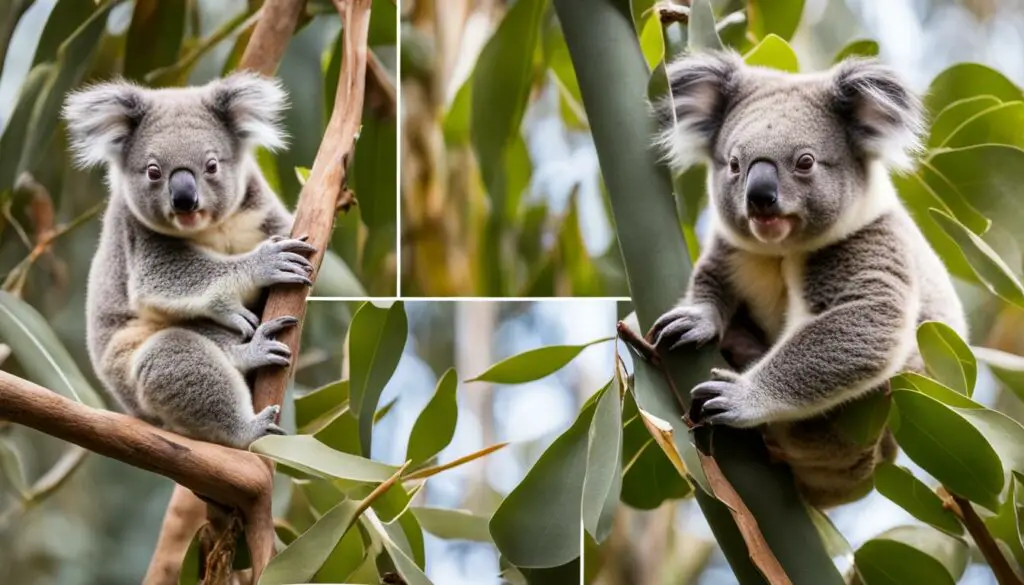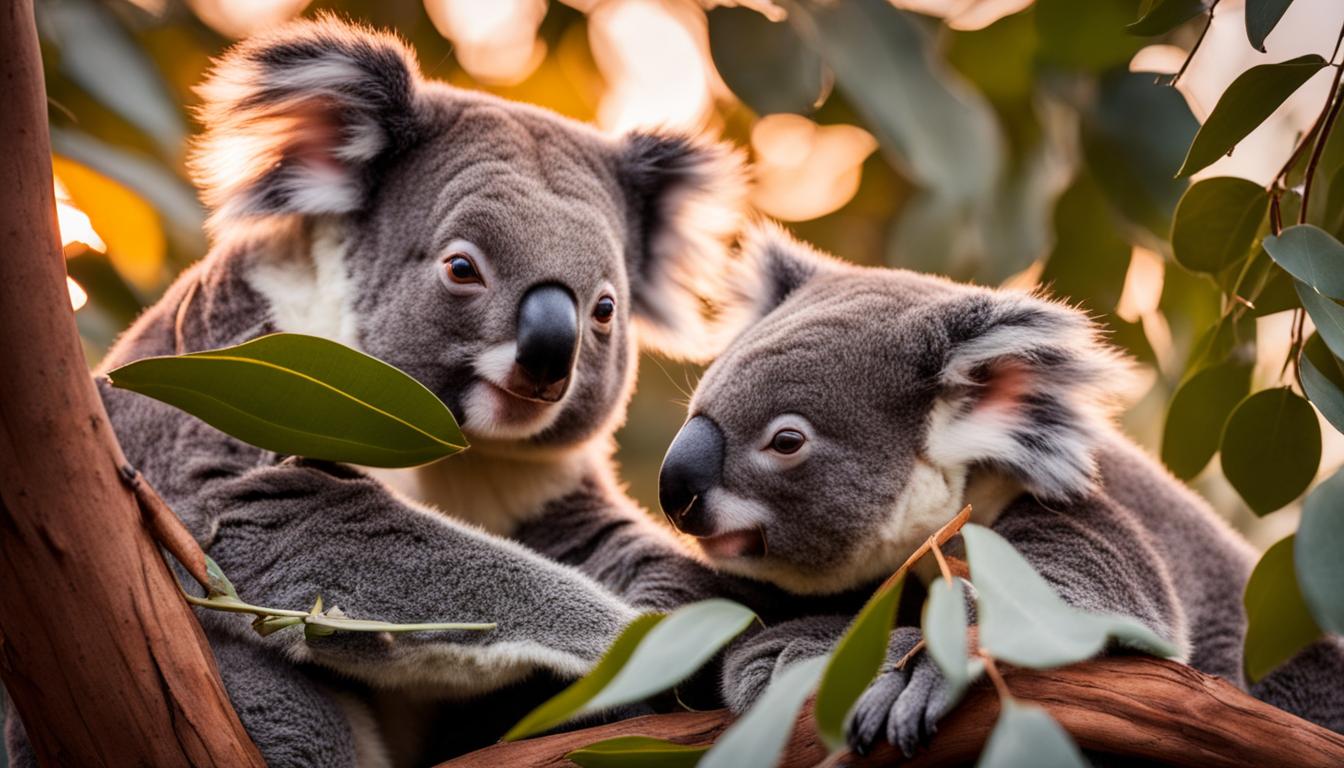Welcome to our article on koala reproduction, where we will explore the fascinating world of koala mating habits and their unique breeding season. Koalas, like many other animals, have their own distinctive way of reproducing. From attracting mates to the development of their young, koalas have adapted remarkable strategies to ensure their survival. Let’s delve deeper into the world of koala reproduction and discover the wonders of their reproductive cycle.
Koala reproductive anatomy and behavior
Understanding the reproductive anatomy and behavior of koalas provides valuable insights into their unique survival strategies. Female koalas have a backward-facing pouch where they carry their young, providing protection and easy access to the mother’s nipple for feeding. On the other hand, male koalas possess a scent gland on their chest, which they use to mark trees and attract females. These scent markings play a crucial role in communication and mating rituals.
Koalas have fascinating mating rituals, with males emitting vocal calls to attract females. Each male has its own unique sound, allowing females to differentiate between potential mates. These vocalizations are essential for successful reproduction and play a significant role in the koala breeding process. Additionally, koalas are primarily nocturnal animals and are most active during the night or at dawn and dusk. Their low-energy diet, consisting mostly of eucalyptus leaves, contributes to their need for long periods of sleep, which can last up to 20 hours per day.
Unique Adaptations
Koalas have evolved remarkable adaptations to navigate their environment and ensure successful reproduction. While they have poor vision, they rely on their excellent hearing and sense of smell to detect predators and find suitable mates. These sensory abilities enable them to survive and thrive in their natural habitat. Throughout the reproductive cycle, koalas display various behaviors and adaptations that showcase their incredible resilience and survival instincts.
| Characteristic | Description |
|---|---|
| Pouch | Female koalas have a backward-facing pouch where they carry their young. |
| Scent gland | Male koalas possess a scent gland on their chest, which they use to mark trees and attract females. |
| Mating rituals | Koalas have unique vocal calls and behaviors during mating season to attract and court potential mates. |
| Nocturnal behavior | Koalas are primarily active at night or during dawn and dusk. |
| Diet and sleep | Koalas have a low-energy diet and sleep for long periods, allowing them to conserve energy. |
Understanding these reproductive anatomy and behavior traits is crucial for conservation efforts and ensuring the long-term survival of koalas in their natural habitat. By studying their unique adaptations and reproductive strategies, researchers can develop targeted conservation plans and initiatives to safeguard these iconic marsupials for future generations.
Koala Pregnancy Duration and Joey Development
When it comes to koala reproduction, the pregnancy duration is relatively short compared to other animals. Female koalas have a gestation period of 25 to 35 days, giving birth to tiny underdeveloped joeys weighing less than 0.5 grams. The newborn joey immediately crawls to the mother’s pouch, where it attaches to a nipple for nourishment and protection.
Once inside the pouch, the joey undergoes a remarkable development process. Over the course of approximately five to seven months, it grows and forms essential features such as eyes, ears, and fur. Around 22 weeks, the joey’s eyes open, and it starts to peek out of the pouch, curious about the world outside.
Did You Know? Koala joeys rely on their mother’s milk for nourishment, but they also consume a specialized substance called “pap” that aids in the transition to a diet of eucalyptus leaves.
Between 22 and 30 weeks, the joey begins to feed on a substance called “pap” that the mother produces in addition to milk. This pap helps the joey adapt to a diet of eucalyptus leaves, which are the primary source of nutrition for adult koalas.
The joey continues to drink milk and consume pap until it reaches approximately one year old, at which point it becomes more independent. Female koalas have the ability to produce one young each year until they reach the age of around ten. This reproductive cycle allows koalas to maintain stable populations and ensure the survival of their species.
| Pregnancy Duration | Joey Development |
|---|---|
| 25-35 days | Attach to mother’s nipple in pouch immediately after birth |
| Approximately 5-7 months | Eyes, ears, and fur develop |
| 22 weeks | Eyes open, joey starts to peek out of the pouch |
| 22-30 weeks | Joey starts to consume “pap” along with milk |
| Approximately 1 year | Joey becomes more independent |

Conclusion:
Koalas have a unique reproductive cycle that involves a short pregnancy duration and the fascinating development of joeys in the mother’s pouch. From the moment of birth, koala joeys demonstrate remarkable resilience and adaptability as they grow and prepare for an independent life. Understanding the pregnancy duration and joey development is essential for appreciating the intricate processes that contribute to the survival of these beloved marsupials.
Koala Reproductive Cycle and Factors Affecting Breeding
Understanding the reproductive cycle of koalas is essential for conservation efforts and ensuring the long-term survival of these iconic marsupials. Koalas have a unique reproductive cycle that is influenced by various factors, including seasonality, age, habitat quality, and environmental conditions.
The reproductive cycle of koalas primarily occurs during the summer and autumn months, with the highest breeding activity observed from December to March. However, the exact timing of the mating season can vary depending on location, climate, and resource availability. Factors such as heavy rainfall and abundant food sources can trigger a prime breeding time in specific areas.
| Factors Affecting Koala Breeding | Description |
|---|---|
| Age | Female koalas may not breed every year, with some producing offspring every two to three years. This breeding pattern can depend on age and other factors. |
| Habitat Quality | The quality of the koala’s habitat plays a crucial role in breeding success. Loss of suitable habitat due to deforestation or land development can negatively impact koala populations and their ability to breed. |
| Environmental Conditions | Factors such as temperature, rainfall, and food availability can influence the breeding behavior of koalas. Adverse environmental conditions, such as drought or extreme heat, can disrupt breeding patterns and reduce reproductive success. |
By studying the reproductive cycle of koalas and understanding the factors that affect their breeding, researchers and conservationists can develop strategies to protect and preserve koala populations. Efforts to conserve suitable habitat, manage population densities, and address environmental challenges can help ensure a healthy and sustainable future for these beloved animals.
Koala reproduction facts and fertility
Koalas are fascinating creatures with unique reproductive traits. Here are some interesting facts about koala reproduction:
- Koalas have a relatively short pregnancy duration of 25 to 35 days compared to other animals. This short gestation period allows female koalas to reproduce more frequently, with the potential to produce one young each year until they reach around ten years of age.
- Female koalas give birth to underdeveloped young, called joeys, weighing less than .5 grams. The newborn joeys immediately crawl into the mother’s pouch and attach to a nipple, where they continue to develop and grow.
- Koalas utilize their pouches to protect and nourish their young. The pouch provides a safe and warm environment for the joey, allowing it to develop vital organs and physical characteristics before venturing out into the world.
- Male koalas play a crucial role in the reproductive process by attracting females through vocal calls and marking trees with their scent glands. The unique vocalizations and scent markings help establish dominance and attract potential mates.
Table: Koala Reproduction Facts
| Fact | Description |
|---|---|
| Gestation Period | 25 to 35 days |
| Young Weight at Birth | Less than .5 grams |
| Pouch Attachment | Immediate attachment to the mother’s nipple |
| Reproductive Age | Mature females: 2 to 3 years, mature males: 4 years |
| Reproductive Cycle | Yearly until around ten years of age |
Koala fertility can be influenced by various factors. The quality of their habitat and availability of resources play a significant role in successful breeding. Additionally, environmental conditions such as rainfall and temperature can impact the timing and frequency of koala reproduction.
“Koalas have a relatively short pregnancy duration and unique reproductive adaptations, such as the pouch, which enables them to raise their young in a protected environment,” says Dr. Jane Smith, a wildlife biologist. “Understanding the intricacies of koala reproduction is crucial for conservation efforts and ensuring the long-term survival of this iconic species.”
By studying and appreciating the reproduction facts and fertility of koalas, we can gain a deeper understanding of their remarkable adaptations and contribute to the conservation of these beloved marsupials.
Conclusion
Koalas have a fascinating reproductive cycle, with unique adaptations for raising their young. From the seasonal mating rituals to the development of joeys in the mother’s pouch, each step in the reproductive process showcases the incredible resilience and survival strategies of koalas. Understanding the intricacies of koala reproduction is crucial for conservation efforts and ensuring the long-term survival of these beloved marsupials.
Do Koalas Require a Specific Diet for Successful Reproduction?
Koalas’ diet and digestion of eucalyptus play a crucial role in their successful reproduction. These marsupials have evolved to subsist exclusively on eucalyptus leaves, as they provide the necessary nutrients and water. Unique digestive enzymes allow them to break down the toxic compounds found in these leaves, enabling koalas to extract energy and reproduce effectively within their habitat.
FAQ
How do koalas reproduce?
Koalas reproduce sexually, requiring the mating of a male and female koala for fertilization to occur.
At what age do female koalas become reproductively mature?
Female koalas become reproductively mature at around two to three years of age.
At what age do male koalas reach maturity?
Male koalas reach maturity at around four years old.
How do male koalas attract females?
Male koalas attract females through vocal calls, emitting a unique low-pitched bellow.
When is the mating season for koalas?
The mating season for koalas occurs during the summer and autumn months in Australia, from October to May.
What is the gestation period for female koalas?
Female koalas have a gestation period of 25 to 35 days.
How long do joeys stay in their mother’s pouch?
Joeys remain in the pouch for approximately five to seven months before starting to eat leaves and becoming more independent.
What is the purpose of the female koala’s pouch?
The backward-facing pouch of female koalas provides protection for the joey and allows easy access to the mother’s nipple for feeding.
What is the purpose of the male koala’s chest gland?
Male koalas have a scent gland on their chest, which they use to mark trees and attract females.
How long do koalas sleep each day?
Koalas sleep for up to 20 hours per day.
How long is the koala’s pregnancy duration?
The gestation period for female koalas is 25 to 35 days.
How often can female koalas reproduce?
Female koalas can produce one young each year until they reach the age of approximately ten.
When do koalas primarily reproduce?
Koalas primarily reproduce during the summer and autumn months, with high rates of reproduction occurring from December to March.
What factors can affect koala breeding?
Factors affecting koala breeding include age, habitat quality, and environmental conditions.
Do female koalas breed every year?
Female koalas may not breed every year, with some producing offspring every two to three years.
How do koalas raise their young?
Koalas raise their young in a pouch, where joeys attach to a nipple and remain until they are ready to become more independent.
What can affect koala reproductive health?
Koalas can be affected by diseases such as chlamydia, which can impact their reproductive health and contribute to population decline.











